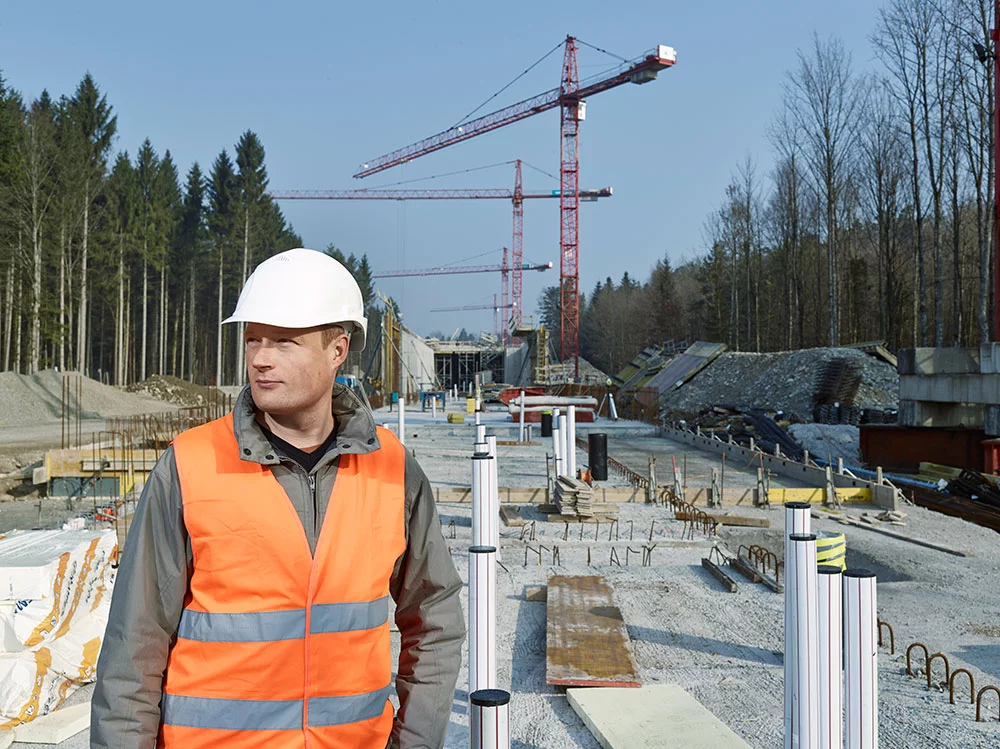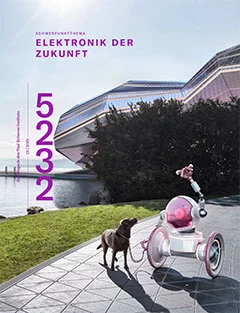When even the earth is too round
There was only one attempt and it had to succeed. After twenty-ton concrete blocks had been piled up for two days solid, the centrepiece, the copper core, was inserted right at the heart of the concrete colossus. It will serve as a beam dump and, in future, be the final destination for electrons on their journey through the Paul Scherrer Institute's (PSI) new large-scale research facility. The 5.6-metre long, 3.1-metre wide and 3.77-metre deep pit was excavated to an accuracy of a few millimetres. Two days later, there was already no trace of it anymore. The pit had been filled and given way to a concrete area, over which the beam channel for SwissFEL already extends. Around 180 tons of concrete now encase the copper core – a cube with a side length of merely fifty centimetres.
The x-ray free-electron laser SwissFEL is currently under construction in Würenlingen Forest, right on the institute's doorstep. The roughly 630-metre long beam channel will house the sections of the facility where SwissFEL's special light is to be generated: very short flashes of x-ray light with the properties of laser light. This involves bringing electrons to a high energy level in a linear accelerator. With the aid of several thousand magnets combined into so-called undulators, the electrons are dispatched on a zigzag course, which forces them to emit x-ray flashes. Having fulfilled their purpose, the electrons then crash into the beam dump's copper core, positioned at a deflection angle of exactly eight degrees.
Correcting the curvature of the earth
During the production of the SwissFEL light, the electrons must not be affected by even the slightest unevenness. The accuracy of the floor in the beam channel is allowed to deviate from the desired value by a maximum of 5 millimetres. Locally, the assembly of the undulators has to be even more precise: To position them exactly, we even need a floor accuracy of plus/minus two millimetres,
says Ivo Widmer, who is responsible for the construction of the building as one of two building and infrastructure project supervisors on behalf of PSI. Each undulator weighs around twenty tons. If the air cushion transporter were to slip on an only slightly uneven floor while unloading the machine components, the undulators could no longer be positioned correctly. Moreover, for the electrons to reach the necessary energy level, their path in the linear accelerator needs to be absolutely straight. Even the slightest bend means a loss of energy, which the comparatively short SwissFEL linear accelerator cannot afford. Consequently, even the earth's curvature needs to be balanced out while constructing the building, which not only requires state-of-the-art measurement technology, but also continuous monitoring. This is achieved with the aid of reference measurement points along the entire building site and a measurement network within the building. As the accuracy of the shell construction has been above average throughout the entire construction process so far, we couldn't detect any critical deviations,
explains Widmer.
Hardly built and already invisible
The bulk of the shell construction work has already been finished and is due for completion in mid-August, by which time around 21,000 cubic metres of concrete will have been used. At the beginning of the summer, it will be possible to walk through the entire beam channel for the first time. The backfilling work is already underway on the building. SwissFEL will barely be visible from outside once it is complete and should encroach on the normal lives of the wild animals in the forest as little as possible. The soil excavated at the beginning of the construction work will be reused for the backfilling and landscaping,
says Gerold Janzi, the second construction and infrastructure co-project supervisor responsible for the project development. He is a member of an interdisciplinary work group that designed a concept for the best possible way to blend SwissFEL into its surroundings. Around 90,000 of the roughly 95,000 cubic metres can be recycled in this manner. In order to avoid damaging the soil, the construction trench had to be excavated with the utmost care and the special location of the roughly five-hectare building site in the woods also requires a careful touch.
Launch of the machine assembly at the end of the year
The construction work is being carried out by the EquiFEL Suisse group, a collaboration between three well-established Swiss companies. Seventy to eighty people work on the building site every day. The consortium is responsible for both the construction of the building and providing the basic infrastructure. Figuratively speaking, EquiFEL Suisse installs all the components right up to the beam delivery,
explains Widmer. The infrastructural development
, namely the installation of the actual facility, will take around two years and is due to get underway at the end of this year. The construction work for SwissFEL is going well. Due to the long winter in early 2013 and the damp forest floor in the spring, the excavation work was initially delayed as the sensitive forest floor would have been damaged too much and become unsuitable for reuse later on down the line. Last winter, however, the weather played ball and, thanks to the mild temperatures, the construction work came on in leaps and bounds.
Text: Martina Gröschl


